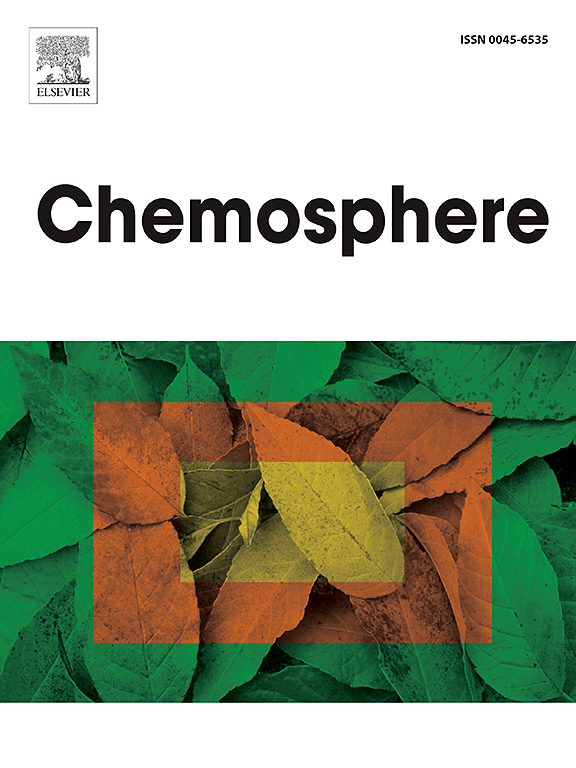鱼角质细胞外植体培养用于先天免疫毒性筛选试验的体内验证:2,4-二氯苯氧乙酸对黑头鲦鱼(Pimephales promelas)角质细胞片迁移的影响
IF 8.1
2区 环境科学与生态学
Q1 ENVIRONMENTAL SCIENCES
引用次数: 0
摘要
2,4-二氯苯氧乙酸(2,4- d)是世界上常用的用于控制外来水生植物的选择性除草剂中的有效成分。关于2,4- d暴露对硬骨鱼先天免疫(如表皮提供的屏障防御)的影响的研究有限。鱼角质细胞外植体培养是一种快速、低成本的皮肤伤口愈合细胞分化和迁移的体外模型。为了验证该检测方法可以作为先天免疫毒性筛选工具的假设,从成年雄性黑头鲦鱼(Pimephales promelas)中非致命地提取含有角化细胞片的鳞片,在2,4- d (0-2,560 ppm)浓度增加的培养基中培养,并测量细胞片的迁移。在24h后,与对照相比,暴露于0.04 ppm时,角化细胞薄片最远迁移距离显著增加,暴露于≥160 ppm 2,4- d时,角化细胞薄片最远迁移距离显著减少。在24小时暴露于2,4- d (0,0.04, 0.4, 4 ppm)的环境应用开始时,对成年雄性黑头鲦鱼进行穿孔活检,然后进行染料渗透试验,观察体内角质细胞片的迁移。在活检后6小时,与对照组相比,暴露于0.04和0.4 ppm 2,4- d的鱼的角化细胞在伤口床上的迁移明显更远。结果表明,角质细胞外植体培养可以模拟与环境相关的体内情景,0.04-4 ppm 2,4- d不会对角质细胞迁移率产生负面影响。未来使用其他环境毒物或鱼类的研究可能会继续探索该试验作为皮肤伤口愈合毒理学影响的实用筛选工具的价值。本文章由计算机程序翻译,如有差异,请以英文原文为准。

In vivo verification of fish keratocyte explant culture for use as innate immunotoxicity screening assay: 2,4-Dicholorphenoxyacetic acid effects in fathead minnow (Pimephales promelas) keratocyte cell sheet migration
2,4-Dichlorphenoxyacetic acid (2,4-D) is the active ingredient in selective herbicides commonly used worldwide to control non-native aquatic plants. Limited research on the impacts of 2,4-D exposure on teleost innate immunity, such as barrier defense provided by epidermis, has been conducted. Fish keratocyte explant culture serves as a rapid, low-cost, cutaneous wound healing in vitro model of cell differentiation and migration. To test the hypothesis that this assay can serve as an innate immunotoxicity screening tool, scales containing keratocyte sheets were non-lethally extracted from adult male fathead minnows (Pimephales promelas), incubated in culture medium with increasing concentrations of 2,4-D (0–2,560 ppm), and cell sheet migration was measured. At 24h post scale pull, keratocyte cell sheet farthest migration distance significantly increased upon exposure to 0.04 ppm and significantly decreased upon exposure to ≥160 ppm 2,4-D as compared to controls. A punch biopsy on adult male fathead minnows was performed at the start of a 24h exposure to environmental application concentrations of 2,4-D (0, 0.04, 0.4, 4 ppm), followed by a dye penetration assay to observe keratocyte cell sheet migration in vivo. At 6h post biopsy, keratocytes migrated significantly farther across the wound bed in fish exposed to 0.04 and 0.4 ppm 2,4-D as compared to controls. Results suggest that keratocyte explant culture can model environmentally relevant in vivo scenarios and that 0.04–4 ppm 2,4-D does not negatively impact keratocyte migration rate. Future studies using other environmental toxicants or fish species may continue to explore the value of this assay as a practical screening tool for toxicological effects on cutaneous wound healing.
求助全文
通过发布文献求助,成功后即可免费获取论文全文。
去求助
来源期刊

Chemosphere
环境科学-环境科学
CiteScore
15.80
自引率
8.00%
发文量
4975
审稿时长
3.4 months
期刊介绍:
Chemosphere, being an international multidisciplinary journal, is dedicated to publishing original communications and review articles on chemicals in the environment. The scope covers a wide range of topics, including the identification, quantification, behavior, fate, toxicology, treatment, and remediation of chemicals in the bio-, hydro-, litho-, and atmosphere, ensuring the broad dissemination of research in this field.
 求助内容:
求助内容: 应助结果提醒方式:
应助结果提醒方式:


